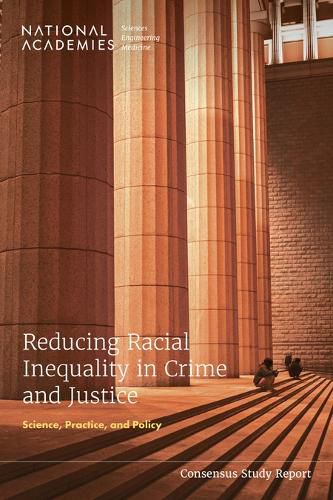Readings Newsletter
Become a Readings Member to make your shopping experience even easier.
Sign in or sign up for free!
You’re not far away from qualifying for FREE standard shipping within Australia
You’ve qualified for FREE standard shipping within Australia
The cart is loading…






The history of the U.S. criminal justice system is marked by racial inequality and sustained by present day policy. Large racial and ethnic disparities exist across the several stages of criminal legal processing, including in arrests, pre-trial detention, and sentencing and incarceration, among others, with Black, Latino, and Native Americans experiencing worse outcomes. The historical legacy of racial exclusion and structural inequalities form the social context for racial inequalities in crime and criminal justice. Racial inequality can drive disparities in crime, victimization, and system involvement.
Reducing Racial Inequality in Crime and Justice: Science, Practice, and Policy synthesizes the evidence on community-based solutions, noncriminal policy interventions, and criminal justice reforms, charting a path toward the reduction of racial inequalities by minimizing harm in ways that also improve community safety. Reversing the effects of structural racism and severing the close connections between racial inequality, criminal harms such as violence, and criminal justice involvement will involve fostering local innovation and evaluation, and coordinating local initiatives with state and federal leadership.
This report also highlights the challenge of creating an accurate, national picture of racial inequality in crime and justice: there is a lack of consistent, reliable data, as well as data transparency and accountability. While the available data points toward trends that Black, Latino, and Native American individuals are overrepresented in the criminal justice system and given more severe punishments compared to White individuals, opportunities for improving research should be explored to better inform decision-making.
Table of Contents
Front Matter Summary 1 Introduction 2 Racial Disparities in Victimization, Offending, and Involvement with the Criminal Justice System 3 Social Drivers of Racial Inequalities in Crime and Justice 4 Criminal Justice Drivers of Racial Inequalities 5 Introduction to Part II 6 Community-Driven Safety and Reducing Harm 7 Non-Criminal Policy Approaches to Reduce Racial Inequalities in Crime and Justice 8 Criminal Justice System Reforms to Reduce Racial Inequality 9 The Federal Role 10 Data and Research Opportunities References Appendix: Biosketches of Committee Members and Staff
$9.00 standard shipping within Australia
FREE standard shipping within Australia for orders over $100.00
Express & International shipping calculated at checkout
The history of the U.S. criminal justice system is marked by racial inequality and sustained by present day policy. Large racial and ethnic disparities exist across the several stages of criminal legal processing, including in arrests, pre-trial detention, and sentencing and incarceration, among others, with Black, Latino, and Native Americans experiencing worse outcomes. The historical legacy of racial exclusion and structural inequalities form the social context for racial inequalities in crime and criminal justice. Racial inequality can drive disparities in crime, victimization, and system involvement.
Reducing Racial Inequality in Crime and Justice: Science, Practice, and Policy synthesizes the evidence on community-based solutions, noncriminal policy interventions, and criminal justice reforms, charting a path toward the reduction of racial inequalities by minimizing harm in ways that also improve community safety. Reversing the effects of structural racism and severing the close connections between racial inequality, criminal harms such as violence, and criminal justice involvement will involve fostering local innovation and evaluation, and coordinating local initiatives with state and federal leadership.
This report also highlights the challenge of creating an accurate, national picture of racial inequality in crime and justice: there is a lack of consistent, reliable data, as well as data transparency and accountability. While the available data points toward trends that Black, Latino, and Native American individuals are overrepresented in the criminal justice system and given more severe punishments compared to White individuals, opportunities for improving research should be explored to better inform decision-making.
Table of Contents
Front Matter Summary 1 Introduction 2 Racial Disparities in Victimization, Offending, and Involvement with the Criminal Justice System 3 Social Drivers of Racial Inequalities in Crime and Justice 4 Criminal Justice Drivers of Racial Inequalities 5 Introduction to Part II 6 Community-Driven Safety and Reducing Harm 7 Non-Criminal Policy Approaches to Reduce Racial Inequalities in Crime and Justice 8 Criminal Justice System Reforms to Reduce Racial Inequality 9 The Federal Role 10 Data and Research Opportunities References Appendix: Biosketches of Committee Members and Staff